The Boogaloo Movement (original) (raw)
Key Points
- The boogaloo movement is an anti-government extremist movement that formed in 2019. In 2020, boogalooers increasingly engaged in real world activities as well as online activities, showing up at protests and rallies around gun rights, pandemic restrictions and police-related killings.
- The term “boogaloo” is a slang reference to a future civil war, a concept boogalooers anticipate and even embrace.
- The ideology of the boogaloo movement is still developing but is primarily anti-government, anti-authority and anti-police in nature.
- Most boogalooers are not white supremacists, though one can find white supremacists within the movement.
- The boogalooers’ anti-police beliefs prompted them to participate widely in the Black Lives Matters protests following the killing of George Floyd by Minneapolis police in May 2020.
- Boogalooers rely on memes and in-jokes, as well as gear and apparel, to create a sense of community and share their ideology.
- Boogalooers have been arrested for crimes up to and including murder and terrorist plots.
I. Origins: From Slang Term to Movement
The boogaloo movement is a developing anti-government extremist movement that arose in 2019 and features a loose anti-government and anti-police ideology. The participation of boogaloo adherents in 2020’s anti-lockdown and Black Lives Matter protests has focused significant attention on the movement, as have the criminal and violent acts committed by some of its adherents.
Before there was a boogaloo movement, there was the concept of “the boogaloo” itself: a slang phrase used as a shorthand reference for a future civil war that became popular in various fringe circles in late 2018. By 2019, people ranging from gun rights activists to libertarians and anarchocapitalists freely used the term “boogaloo,” urging people to be “boogaloo ready” or even to “bring on the boogaloo.” The term itself didn’t specify a type of civil conflict, allowing different types of extremists to insert their own particular fantasies as the concept spread on numerous discussion forums and social media sites.
The term itself derives from a longstanding joke referencing the 1984 film Breakin’ 2: Electric Boogaloo, in which the first part of the film’s title is replaced by something else to suggest some sort of sequel. When George W. Bush followed in his father’s footsteps to the U.S. presidency, for example, some people jokingly referred to it as “Bush 2: Electric Boogaloo.”
“Civil War 2: Electric Boogaloo” was one longstanding version of this joke. In recent years, however, some people used this phrase to refer to a future conflict over the issue of guns or gun confiscations. Such references have appeared on a variety of platforms, making it difficult to pinpoint their conceptual origins. However, the website Bellingcat suggested in May 2020 that the “Weapons” forum (or “board”) of the website 4chan “appears to be” where the term became regularly used in this context.
ADL research has confirmed the likelihood that conversations in the weapons forum (more commonly known as “/k/”) solidified the boogaloo concept. For years, “electric boogaloo” jokes and references of all kinds were a popular trope in posts on /k/. Among them were “Civil War 2: Electric Boogaloo” references, many of which posited a future civil war started over the issue of guns, such as gun owners rising up to prevent guns from being confiscated. “I went from a gun owner, hunter and light prepper,” claimed one /k/ poster in December 2018, “to awaiting the great American civil war 2 electric boogaloo.” Other /k/ denizens used the “Civil War 2” reference to describe other versions of a future conflict, such as a war between liberals and conservatives or a war between different races.
Such civil war “boogaloo” references became increasingly common on /k/ from summer 2018 onward. By the end of 2018, so many people were familiar with “Civil War 2: Electric boogaloo” that /k/ posters discovered they could drop the first part and people would still understand what they were referring to. “Shame Asians don’t ally with whites,” claimed one /k/ resident in October 2018. “It’d be nice to have other people capable of civilization standing by when electric boogaloo comes.” Another person asked on /k/ in December 2018 how people would “fight in the Electric Boogaloo if they don’t have a gun?”
Eventually, the word “electric” also fell by the wayside. “When the boogaloo starts, antifa and civnatfags will be slaughtered by their pets in under a week,” claimed one poster in November 2018 (the term “civnatfags” is 4chan slang for so-called “civic nationalists” or alt-lite extremists). “Can’t wait for boogaloo,” wrote another /k/ poster that month. “You want your fight? You got it.”
By 2019 the concept of “boogaloo” as a future civil war had spread widely. Though it was still an inchoate concept, in which white supremacists might use it in one context, such as race war, while militia adherents or gun enthusiasts might refer to it terms of government overreach or gun grabbing, an emerging online community quickly developed its own vocabulary and memes. Variations of the term “boogaloo” emerged, like “Big Igloo” and “Big Luau,” humorous sound-alike alternatives that spawned some of the earliest boogaloo symbols, such as igloo images and tropical shirts. “Big Igloo” spawned variants such as “icehouse,” while the phrase “Big Luau” led to numerous party-themed synonyms for the boogaloo, including “hoedown” and “hootenanny” (as in “the big hootenanny”), as well as “fiesta” or “spicy fiesta” (with the word “fajitas” sometimes used as a substitute for “guns” or “rights”).
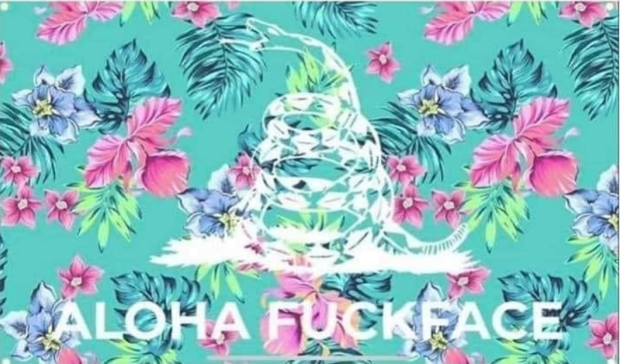
Boogaloo-related memes solidified the boogaloo concept. Memes are discussed in greater detail below, but they were important not only in creating a conceptual framework for the boogaloo but also in helping to turn the boogaloo from a concept into a movement. Some of the first online boogaloo spaces, such as Facebook groups, were primarily for sharing memes.
By mid-2019, “boogaloo” had become more than just a slang term; an actual movement was cohering around the concept. It is important to distinguish between the people who have used or may use the term “boogaloo” to mean a future civil war and those people who have actually become part of the boogaloo movement itself. In particular, though white supremacists also used or promoted the use of the term “boogaloo” in 2019-20—including some accelerationist white supremacists who used it in the context of a future race war -- for the most part they did not become part of the movement itself.
People who did join the movement adopted terms to describe themselves, such as boogaloo bois/boys, boogs, and boojihadeen. They also created physical artifacts to proclaim their allegiance, including distinctive symbols, flags, patches, clothing, and stickers.
Boogalooers grew rapidly over the next year, primarily through online spread. One boogaloo Facebook page, the Big Igloo Bois page, garnered more than 32,000 “likes” before Facebook took it down in June 2020. Facebook page “likes” used as a measurement tend to overstate actual support for extremist causes, but numerous boogaloo Facebook groups (i.e., discussion forums) achieved significant memberships as well. HonoLuau Sunrise, a boogaloo Facebook group created on June 30, 2020, accumulated more than 2,000 members by August 5. CNN Bois, another boogaloo Facebook group created around the same time, reached 9,400 members in just a couple weeks (before Facebook took it down). Not all online participants are necessarily true believers, but it seems fairly clear that the boogaloo movement likely surpassed 10,000 adherents by summer 2020. The number of boogalooers taking part in real world activities, as opposed to merely online activities, has been much smaller.
II. The Ideologies and Beliefs of the Boogaloo Movement
Much of the ideology of the boogaloo movement originated in other fringe movements and subcultures. Though some boogalooers joined the movement as their first experience with fringe or extreme beliefs, others had previous exposure to different beliefs and philosophies, which they brought with them to the boogaloo movement.
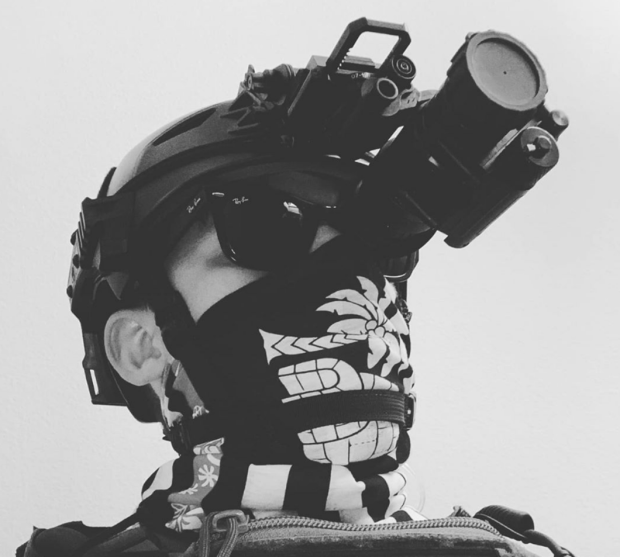
One important subculture that influenced the boogaloo movement is the “chan” subculture common to forums like 4chan, with its emphasis on memes, trolling and deliberate irreverence. Another important subculture was America’s hardcore firearms subculture (a small percentage of Americans own a large portion of the total firearms in the country), itself closely linked to the single-issue RKBA (right to keep and bear arms) movement.
Even more influential have been several minimalist government philosophies. These include libertarianism (which promotes individual freedoms and seeks minimal government), anarchocapitalism (which seeks the removal of central governments but emphasizes private property and the free market), voluntaryism (which advocates all relationships be based on mutual consent), and minarchism (which seeks a minimal government that performs only certain specified functions).
Of the two, libertarianism and anarchocapitalism are the most influential within the boogaloo movement. Many boogalooers strongly support Jo Jorgenson, the 2020 Libertarian Party candidate for president. Jorgenson herself appeared on a boogaloo-related podcast in the summer of 2020. Spike Cohen, the party’s vice-presidential nominee, also has had ties to boogalooers. Anarchocapitalist (or “ancap”) references and imagery are also very common among boogalooers.
These anti-government philosophies have helped make the boogaloo movement staunchly anti-authoritarian, anti-state, and anti-police in nature.
Some boogalooers have ties to another anti-government extremist movement: the militia movement (including Three Percenters). This movement, motivated by conspiracy theories and a fixation on firearms, has historically opposed the federal government and federal law enforcement. Its adherents viewed the federal government as analogous to the British during the American Revolution and saw themselves as patriots protecting Americans and their liberties.
The militia movement long focused on perceived victims of government, like those killed by federal agents during deadly standoffs at Ruby Ridge, Idaho, in 1992 and Waco, Texas, in 1993. It had a strong vein of anti-law enforcement sentiment and also sought a minimalist, libertarian-like government.
However, the recent history of the militia movement during the Trump administration has caused many boogalooers to take a dim view of the movement. The militia and Three Percenters strongly supported Donald Trump—the first major party nominee the movement ever supported— and his election in 2016 caused the movement to lose much of its anti-government fervor; it is hard to be intensely anti-government while strongly supporting the person at its head.
Boogalooers certainly noticed. “[Militia/Three Percenters] are always ready to take a knee and blow the state as long as they have an R in front of their name,” wrote one boogalooer to a Facebook group in June 2020. Another called them “3per maga cucks.” Another group member, a Three Percenter himself, agreed: “They’ve gone from protectors of tyranny to protectors of the tyrants. It breaks my heart seeing them act this way.”
In many respects, the boogaloo movement resembles a reincarnation of the pre-Trump militia movement, though stripped of the militia movement’s focus on New World Order conspiracy theories. Boogalooers hold the anti-government and anti-law enforcement attitudes common in the early years of the militia movement. They also regularly make Revolutionary War references—with some even insisting that “boogaloo” doesn’t stand for “Civil War 2” but rather “American Revolution 2.” Boogalooers frequently reference Ruby Ridge and Waco, even though those events occurred before many boogalooers were even born.
Had the election of Trump not sapped the anti-government anger of the militia movement, many people who are boogalooers today might have joined militia or Three Percenter groups instead.
The still-developing boogaloo movement doesn’t yet have a concrete ideology but does have a set of shared ideas orbiting the concept of a future “boogaloo”. These include:
The Enemy. Boogalooers are, in general, anti-government, anti-state and anti-police, but not always in equal measure. A debate that took place on one boogaloo-related Facebook page in late June 2020 illustrates the differences among boogalooers. “Just a reminder,” posted “Chief Boogaloo” to his page, “police are not the enemy here. It’s the jackasses in power. The will of the few is imposed on the many here.”
But this idea immediately met pushback. “Tyrants don’t enforce their own laws,” responded another boogalooer. “Cops do it for them. Cops are 100% the enemy. That’s like saying King George was the only enemy. Not the redcoats who went to kill the colonists.” This idea had support from others. “I agree 100%,” wrote a third, “They are absolutely the enemy.”
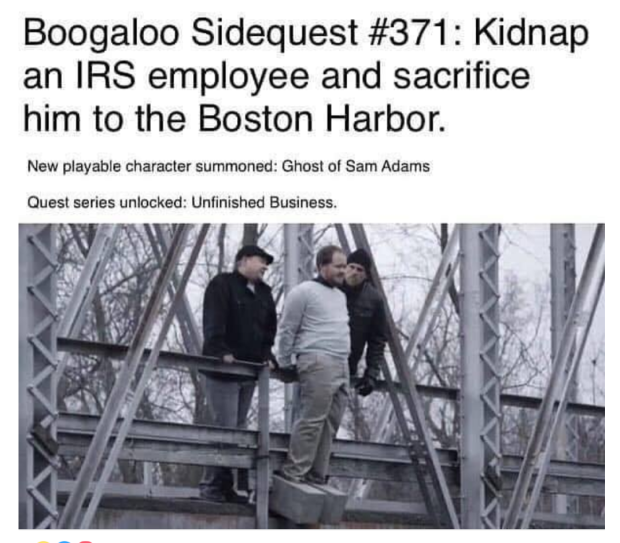
Violence. The idea of violence is widely accepted within the boogaloo movement; one boogaloo meme uses an image from The Simpsons cartoon to make the point that the purpose of the “boojahideen” is to implement “violently installed Freedom and Liberty” against the federal government. “We don’t want civil war,” explained a boogalooer on the HonoLuau Sunrise Facebook group in July 2020, “we want the politicians’ heads on spikes.”
When a moderator of one popular boogaloo page announced in July 2020 that “P A T R I O T Wave” did not support violence, he was met with immediate pushback. “I condone acts of violence,” responded one boogalooer. “At some point,” wrote another, “you have to support violence.” In July 2020, Chris Stone, the administrator of one Facebook boogaloo group, “Fiesta Aficianados Anonymous,” announced that his group “is for those completely willing to Fiesta [i.e., start the boogaloo], but who would also like to reach out and try to avoid the Fiesta while maintaining their Fajitas [guns/rights].”
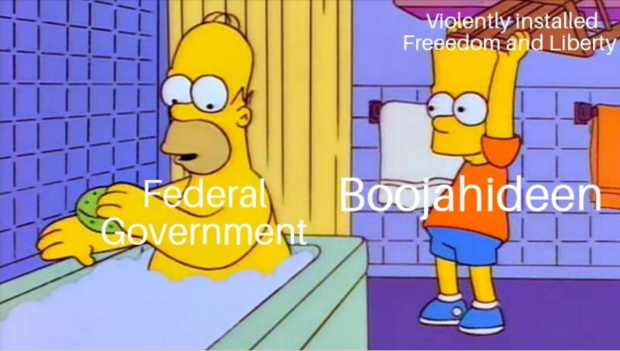
Boogalooers often discuss how or when to engage in violence. Many think of violence in reactive rather than proactive terms—such as responding with violence to law enforcement attempts to enforce “Red Flag” laws (laws that allow the temporary confiscation of firearms from those deemed to be a threat to themselves or others for mental health or other reasons). “Some of y’all probably know it’s a matter of time before you get the flag and [are] getting ready accordingly,” posted someone calling themselves “Boojahideen” to Facebook in January 2020. “…A few can’t wait for it to happen.” One meme posted to Facebook in late 2019 depicted the boogaloo starting in reaction to “the final unjust gun and/or tax law.”
Mobilization. “Rebellion is in our blood,” proclaimed one Facebook boogaloo page, “Tropical Aloha Vibes,” in July 2020. “According to most people,” wrote Caleb Erlenbach for the Join the Uprising website in September 2019, “10-15% support [in the population] for the boogaloo is a conservative estimate. 5% of 340 million is 17 million.” Other boogalooers, not so self-assured, have felt the urge to mobilize people to action. “What shall history remember us as?” asked one of the moderators of the “P A T R I O T Wave” Facebook page in June 2020. “Shall we be remembered as the poor, terrified, and pathetic cowards who let slip the reigns of their great nation unto the dogs of the filth and the corrupt?...Or…shall we be the Americans who dared to stand when the nation knelt?” A month later, the moderator of “Tropical Aloha Vibes” made a similar call to arms: “Will you answer the call? Will you choose freedom over comfort?...Will you turn a blind eye, or will you ravage your tyrants? SIC SEMPER TYRANNIS.”
The Left. The boogaloo movement is a right-wing extremist movement, with most of its adherents coming from various fringe right-wing movements or philosophies. As a result, boogalooer attitudes towards the left range from moderately to extremely hostile. Many picture the boogaloo as being directed primarily or substantially against the left itself.
At the same time, because the movement is so new that it lacks the ideological coherency of more mature movements, one can find individuals in boogaloo movement spaces who evince left-leaning ideas. Typically, such individuals are left-leaning libertarians who may have some liberal or progressive social views while at the same time being hostile to left-leaning views about the role of government. Benjamin Ryan Teeter, one of two boogalooers charged in September with attempting to provide material support to Hamas, identified himself on social media as a “left anarchist.” There are also a few ties between boogalooers and left-leaning pro-gun groups. In March 2020, a Facebook group for left-oriented boogaloo memes emerged. Originally called the Leftist Boogaloo Side Quest Memes group, it later changed its name to Leftist Side Quest Memes (a “side quest” is an optional goal in a video game). As of mid-August 2020, the group had more than 800 members discussing “what we would do in a Boogaloo situation.”
Pedophiles. Although boogalooers primarily oppose the government and police, the movement does have other interests. Perhaps the most prominent—and unusual—of these is an obsession with pedophiles. This fixation may have been inherited in part from the 4chan subculture, which has had its own longstanding focus on pedophiles, and in part from pedophilia-related conspiracy theories such as “Pizzagate” (a 2016 theory that claimed a pedophile sex-slave ring connected to prominent Democrats was being operated from a Washington, D.C., pizza parlor) and Jeffrey Epstein, the wealthy financier and convicted sex offender whose 2019 jail suicide spawned numerous conspiracy theories in both left-wing and right-wing circles. It is possible that QAnon, a popular right-wing conspiracy theory that evolved as a grander and more elaborate version of Pizzagate, may have also had some influence, though connections between QAnon and the boogaloo movement are limited.
Boogalooers want pedophiles to die, whether at the hands of law enforcement or boogalooers themselves. “The fuking [sic] FBI is not protecting children anymore,” wrote a boogalooer to the HonoLuau Sunrise Facebook group in July 2020, “and if your [sic] a Fed boi reading this on this page you need to fuking [sic] get back to the constitution and yeet [shoot/kill] these fuking [sic] pedos.” Boogalooers frequently share sentiments or memes about “yeeting” pedophiles or putting pedophiles in woodchippers. “Feet first into the wood chipper!” announced the moderator of Tropical Aloha Vibes in July 2020 when sharing a pedophile-related meme. “I cannot stress this enough,” posted user boog4liberty on Instagram in March 2020, “#pedos #tyrants and #commies get the #yeet during the #boogaloo free helicopter rides and skydiving lessons for them.”
III. The Boogaloo Movement and Racism/White Supremacy
When the boogaloo movement first emerged publicly, a number of journalists characterized it as a white supremacist movement seeking to start a race war. This characterization occurred in part from early promotion of the term “boogaloo” by white supremacists such as Paul Nehlen and its approving use by some white supremacists, especially accelerationists.
However, using the term “boogaloo” is not equivalent to joining the boogaloo movement, which consists primarily of anti-government and anti-police extremists and even has a few people of color in its ranks. “We are not racist,” wrote one boogalooer on his Facebook profile in April 2020 in response to media characterizations of the boogaloo movement as white supremacist. “[The] only hate I have is for overreaching government.”
Many boogalooers have complained about media coverage linking them to white supremacists. “Chief Boogaloo” claimed in June 2020 that one news organization was “trying to run more effective smear campaigns based off of ignorant ass information.” Another boogalooer, using the screen name “Booga Schwan,” asked on Facebook the following month, “Do you think they’ll ever ACTUALLY talk to any of us?” He claimed to have written to media outlets pushing back against their characterization, with no response. “Trying to make it racial is for ratings and readers,” he concluded.
Yet there are people with racist or even white supremacist beliefs who do try to participate in boogaloo movement spaces online or in real world activities. “I’m noticing an infiltration [of racists],” wrote one person on a boogaloo Facebook group in July 2020. The poster, a libertarian-leaning Black woman who goes by Clarese Nakiea, also claimed to run a boogaloo Facebook group herself. The fact that moderators of boogaloo-related groups and chat rooms do occasionally kick out racists or white supremacists also illustrates that there are people with such views interested in the movement. Racist boogalooers who avoid making explicitly racist or antisemitic posts can evade detection altogether.
Some, however, are quite open about their racist or white supremacist beliefs. One boogalooer active on Facebook and Twitter as “Molotov,” is an explicit white supremacist who believes in race war, arguing as he did in late July on Twitter, “the only answer is to give blood and steel.” The previous month he extended an offer to journalists to interview him, as “an active member of [the boogaloo] community,” so that he could “help shine a light on the good aspects.”
With the movement’s public image in mind, boogalooers often insist their movement is not racist. “The Thin Hawaiian Line does not discriminate,” declared the owner of Fenix Ammunition, a small Michigan-based business linked to the boogaloo movement, on the company’s Facebook page in June 2020. In May, Fenix posted a meme featuring people (labeled as “boog bois” of different colors) linking arms under the banner of “hating racists.” Another boogalooer, “Chief Boogaloo,” posted on Facebook in June that “the Boog has zero tolerance or time for racism, ignorance, and stupidity,” suggesting that the “proverbial ‘they’” seek to ignite “division of the masses.”
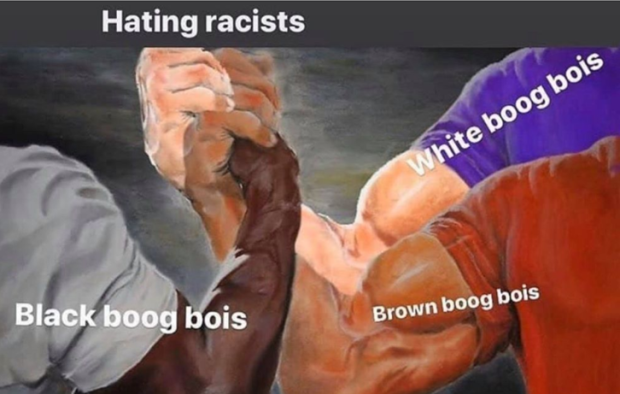
Many of the boogaloo movement’s expressions of anti-racism include violence. One common boogaloo meme features a boogalooer shooting a white supremacist who has asked to “boogaloo” with them. Other boogaloo memes promote the “yeeting” (shooting or killing) white supremacists or otherwise threatening them with violence.
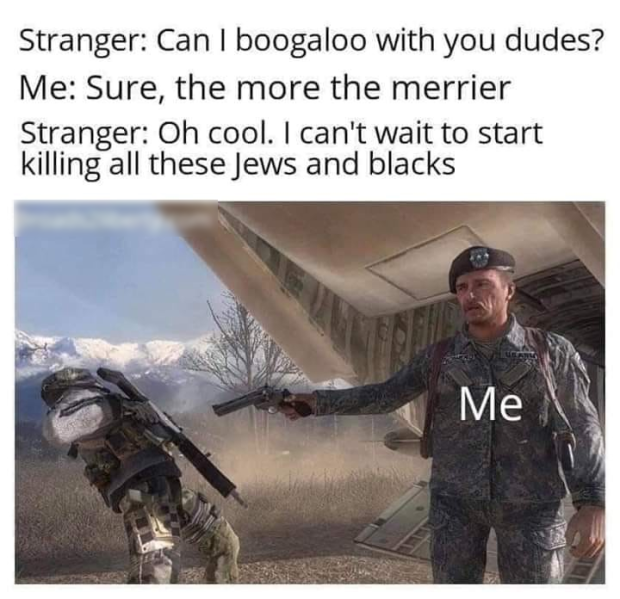
IV. Boogaloo and BLM
The protests that followed the killing of George Floyd by police officers in Minneapolis in May 2020 included a number of boogalooers, who showed up with military gear, weapons, tropical shirts and other boogaloo symbols. Most boogalooers who took part did so because of their own strong anti-police attitudes, perceiving an opportunity to make common cause with others angry about police brutality. “To focus on the immediate threat and the common enemy is how we move forward,” claimed an administrator of a popular boogaloo Facebook group, the Big Igloo Bois, in late May 2020, while “setting aside some differences [with Black Lives Matter] no matter how seemingly big they are.”
The leader of a Tennessee-based boogaloo group encouraged people to show up at protests, arguing, “This could be a major opportunity for the liberty movement to be publicized and brought into a new light.” During the first week of protests alone, boogalooers showed up at demonstrations in at least 11 different cities.

As boogalooers participated in BLM protests, many shared photographs of themselves posing with Black protesters and members of groups like Black Guns Matter. For boogalooers, such photographs were clear visual evidence that their movement was not white supremacist.

Boogalooers have also integrated some martyrs of the Black Lives Movement into their own pantheon of people who died at the hands of police. One widely shared boogaloo meme, which appears in several variations, displays the boogaloo “igloo” flag while listing numerous right-wing extremists killed by police (including Vicki Weaver, Duncan Lemp and Robert LaVoy Finicum) alongside Black people killed by police (such as Oscar Grant, Breonna Taylor and Eric Garner).
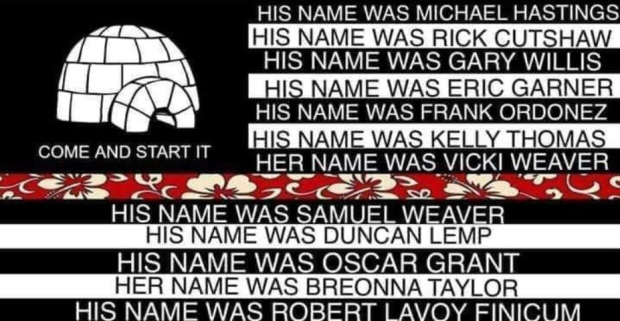
Of people of color killed by police, boogalooers seem to reference Breonna Taylor most frequently. Taylor was killed in March 2020 by police officers executing a no-knock search warrant in Louisville, Kentucky; her case contains many elements that incite adherents of the boogaloo movement, including police violence, no-knock warrants and a civilian (in this case, Taylor’s boyfriend) using a firearm to defend himself. For many boogalooers, the circumstances of the shooting of Taylor also bear a strong resemblance to those surrounding the killing of boogalooer Duncan Lemp by police in Maryland that same month.
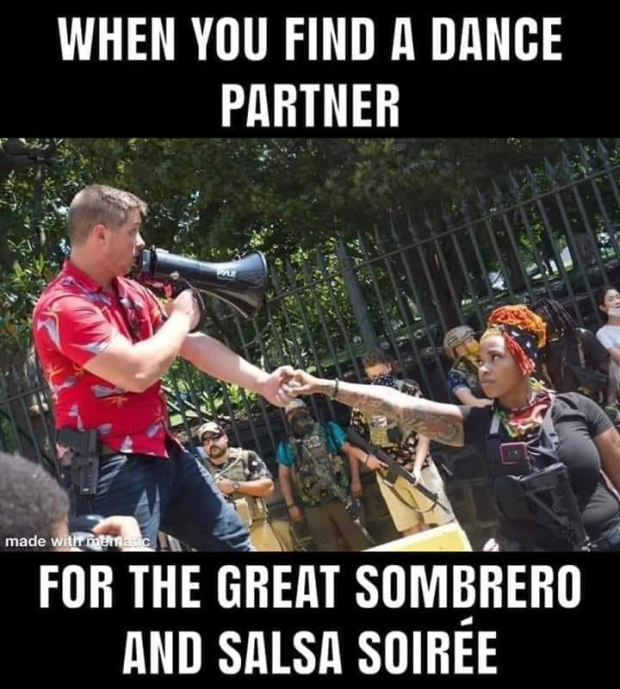
One boogalooer has actually been killed while taking part in a Black Lives Matter protest. In late July 2020, a motorist shot and killed Garrett Foster while Foster was participating in a BLM protest in Austin, Texas. Foster was a frequent presence at protests against police brutality in Austin, often accompanying his Black fiancée, Whitney Mitchell. Foster’s social media postings included several boogaloo-related posts in the months before he was shot, while after the shooting one person claimed on a boogaloo Facebook page that Foster had been part of his group, “providing a security escort for the march.” Boogalooers across the internet responded to Foster’s death with the slogan, “Aloha ‘til Valhalla.”
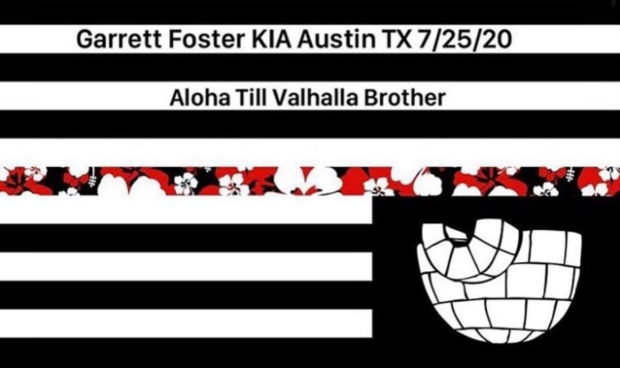
Despite the number of boogalooers at BLM protests, the boogaloo movement is not united in support of BLM. While some boogalooers have been highly supportive, others have cast a more jaundiced eye on the movement. “Fuck BLM,” declared one boogalooer on Facebook in late May, “[they’re] one of the most racist groups out there.” It is “ignorant,” posted another a few days later, “to think BLM isn’t a terrorist organization filled with black supremacists, and white liberal Marxists.”
“Imagine marching with Marxists,” one boogalooer wrote on Facebook in early July after seeing a photograph of boogalooers and BLM protesters together in Virginia. “I’m lost,” wrote one member of a boogaloo Facebook group on July 6. “When I first got into the fiesta it was extremely anti-communist. Now we’re allying with a known communist organization?”
Other boogalooers have claimed that only the BLM leadership is Marxist/communist. “Most of the people marching under the banner have no clue what the leadership of BLM is about,” wrote another boogalooer. “They are strictly marching for the lives lost. Those people’s hearts are in the right places.” Another agreed: “A great deal of the members are not Marxists, unlike the BLM leaders.”
Overall, boogalooers tend to be very sympathetic to the narrow cause of opposing police violence, while less supportive or even antagonistic towards other BLM goals.
V. The Boogaloo Social Media Presence and Communications
Social media played a significant role in the creation and growth of the boogaloo movement. Mainstream social media platforms like Instagram and Reddit helped the boogaloo concept spread from obscure online spaces like 4chan’s /k/. Boogalooers capitalized on the platforms’ large audiences to spread their message and draw new supporters who brought a range of ideologies to the table.
Perhaps no social media platform was more integral to the rise of the boogaloo network than Facebook. For nearly a year, from mid-2019 through mid-2020, boogalooers were able to freely share memes advocating revolution or civil war, as well as violence against the government or law enforcement, in public and private Facebook groups and on public Facebook pages. Scores of boogaloo pages and groups attracted thousands of Facebook users. These platforms allowed users to spread extremist rhetoric and form connections with each other. For example, the three self-identified boogalooers arrested in May 2020 for allegedly plotting to incite BLM protesters against police in Las Vegas were all members of the same Nevada-based boogaloo Facebook group.
In the spring of 2020, as publicity around the boogaloo movement grew, Facebook finally took steps to curb the boogalooer presence on its platform. On May 1, 2020, Facebook banned the use of “boogaloo” and related terms when paired with references to weapons or calls to action. On June 4, following the Las Vegas arrests, the social media company announced that its algorithms would no longer recommend boogaloo groups. Finally, on June 30, Facebook removed several hundred boogaloo accounts and groups from its platform and said boogaloo content was banned from its platform.
Boogalooers responded to the Facebook “purge” in two primary ways. Some moved to other platforms, where they hoped to find a more permissive environment. MeWe and Discord emerged as two popular destinations, though Discord also disabled boogaloo-related accounts and chat channels in June. Boogalooers also tried platforms such as KeyBase, Slack, Guilded and RocketChat. However, though boogalooers were able to establish some traffic on several platforms, none matched the size of the Facebook audience and itinerant boogalooers have struggled to thrive.
Many boogalooers have opted to remain on Facebook and attempt to evade the ban, at the risk of having their pages and groups deleted. To increase their survival odds, boogalooers are avoiding the term “boogaloo,” using different names and code phrases as camouflage.
Initially, many boogalooers substituted other tropical phrases for “big luau,” employed alternative arctic references for “big igloo,” or used seemingly unrelated phrases like “Mike Honcho’s Fun House,” or simply “[redacted].” As restrictions tightened, boogalooers adopted more imaginative terms, such as substituting “spicy fiesta” or “baja blast” for “big luau.” In one campaign following the June 30 removals, boogalooers named new groups after established media brands like CNN, NBC, and Vice News and referred to themselves as journalists, hoping to make it harder for social media platforms to find and take down their pages.
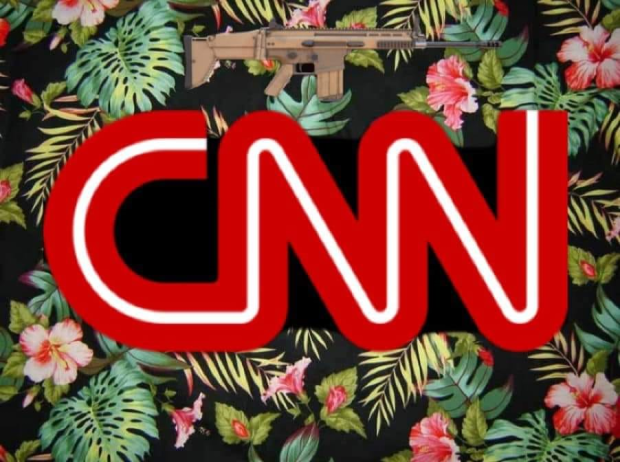
The ability of boogalooers to quickly rebrand illustrates the resilience of the movement and leaves Facebook playing catch-up. What matters to boogalooers is the concept of the boogaloo, not a centralized organization or even the word “boogaloo” itself. Its decentralized model means anyone can start a boogaloo-related page or group; if a particular term becomes too well-known on Facebook, boogalooers simply replace it with another in-joke reference or take a seemingly random word or concept, imbuing it with meaning they originally gave to “boogaloo.” As one boogaloo meme referencing the 2019 movie Joker put it, “Please forgive my laughter, some people think we care what it’s called.”
The creation and sharing of memes is especially important to the boogaloo movement. These combinations of text and imagery are a key way the movement spreads its ideas. In particular, boogalooers often employ “shitposting,” a form of communication common on platforms such as 4chan, where users filter extreme, violent or hateful messages through darkly humorous memes and messages.
Boogalooers memes often use common internet jokes and pop culture and video game references to communicate their beliefs. In boogaloo internet spaces it is common to see memes glorifying the future civil war, emphasizing the need to prepare for it, encouraging violent behavior, espousing hostility towards law enforcement, or even mocking how crazy boogalooers must appear to outsiders.
In the tradition of shitposting, these memes are steeped in humor and irony, a tactic that serves three purposes. First, they make boogaloo messaging more appealing because people enjoy humor and are more likely to share a humorous meme. Second, boogalooers make the content more digestible by softening the violent underpinnings of some of their beliefs: while many people might reject an explicit call for violence against police, some might be more receptive to a meme that cloaks such violent sentiment with an overlay of humor. Finally, humor-infused memes provide posters with plausible deniability if they are questioned by authorities, since they can claim they were only joking.

Though boogaloo-related memes typically take the outward form of common internet jokes, the messages are often rife with in-group language and shared cultural references. This in-group language helps followers identify fellow boogaloo supporters and avoid censorship.
Early “joke” slang and nicknames, like “Big Luau” and “Big Igloo,” as well as alternative names for boogalooers, such as boog or boojahideen, could be used both as jokes and as methods of avoiding censorship. These original variations inspired much of the boogaloo iconography, including Hawaiian shirts, tropical patches, and the igloo that appears on the boogaloo flag.
Common topics of discussion include the coming conflict and how to prepare for it, what weapons and gear to obtain or to include in their “boog kits,” what the boogaloo will look like, and what might come after. Boogalooers may also mock or threaten enemies such as law enforcement—the “alphabet bois” or “soup bois.”
Some refer to themselves as boogaloo martyr Duncan Lemp when interviewed by media, while others use “Duncan Lemp” as a screen name. Lemp-related hashtags such as #weareDuncanLemp, #JusticeforDuncan, and #SayHisName are commonplace.
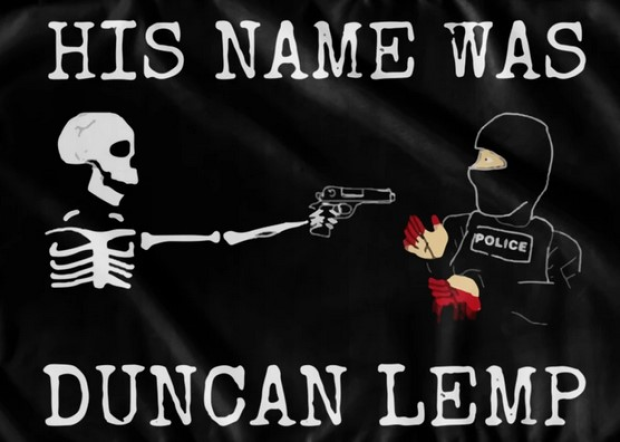
VI. Boogaloo Real World Activity
Though boogaloo movement activity remains predominantly online, by late 2019 boogalooers had started to venture into the physical world, a process that accelerated in 2020. In particular, boogalooers have been drawn to three types of protests and events: 1) rallies promoting gun rights or opposing gun control measures; 2) the nationwide protests in April and May decrying coronavirus lockdown measures implemented by state governments; and 3) the Black Lives Matter protests across the country that followed the killing of George Floyd in May. Each type of event reflects a different concern of the boogaloo movement.
Firearms first drew boogalooers into the public sphere, as states around the country debated gun control measures in the wake of high profile shootings like the August 2019 El Paso shooting spree by white supremacist Patrick Crusius. On January 20, 2020, the Virginia Civil Defense League (VCDL), one of the state’s largest Second Amendment groups, hosted a gun rights “Lobby Day” on the steps of the state capital in Richmond, Virginia, that attracted thousands of pro-gun activists and anti-government extremists from across the country. Before the event, some commenters had called for a boogaloo in response to any effort to impose stricter gun measures; the VCDL itself encouraged this attitude by sharing a YouTube video that asked whether the boogaloo was about to begin in Virginia. On “Lobby Day,” boogalooers wearing Hawaiian shirts were among the protesters. One attendee, a member of a boogaloo Facebook group called “Patriot Wave,” carried a sign that read, “I have a dream of a Boogaloo.”
In spring 2020, coronavirus-related events took center stage. As the virus spread, prompting many states to implement lockdown measures to combat it, the anti-authority boogaloo movement found a new cause. Protests against lockdown measures began in late March, organized largely by antigovernment extremists, and gained steam in April as more mainstream conservative organizations picked up the cause.
Boogalooers appeared at a number of these anti-lockdown protests, framing the lockdown measures as the efforts of a tyrannical government to strip Americans of their liberties. At protests across the country, boogalooers attended rallies as individuals or in small groups, sometimes openly advocating for a civil war. Most wore Hawaiian shirts and many were armed. At one rally in Olympia, Washington, on April 19, Matt Marshall, the leader of a local Three Percenter group, encouraged his followers to come wearing the boogaloo-linked clothing. Others showed their support for a future civil war by carrying signs, such as one in Sacramento, California, that read, “Give Me Liberty or Give Me Boogaloo.”
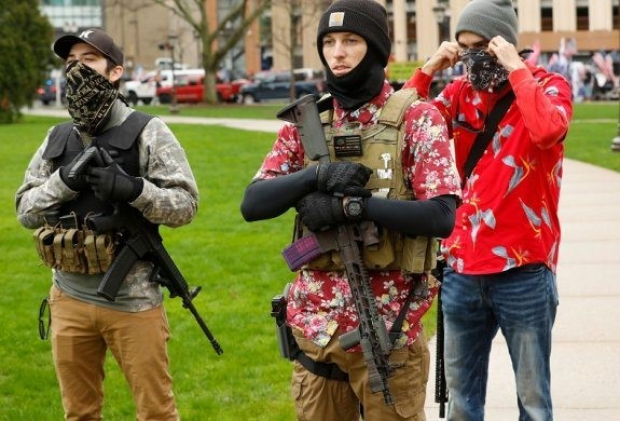
Usually, boogaloo supporters appeared at protests organized by others. However, in May, members of the Facebook group “Blue Igloo” organized several small protests in Raleigh, North Carolina.
In early lockdown protests, boogalooers tended to take a relatively passive role, letting their attire, symbols, and firearms send messages for them. Later, as some local businesses decided to ignore local mandates and reopen, some boogalooers discussed showing up at such establishments to ”protect” them from local officials. This came to pass on May 4 in West Odessa, Texas, where a bar owner and seven protesters--six of whom were armed--were arrested following a standoff with local authorities over the bar’s reopening. One of the arrested protesters, Wyatt Winn, had liked numerous boogaloo pages on Facebook, posed for photos with armed men wearing Hawaiian shirts, and shared memes referencing Duncan Lemp.
The killing of George Floyd at the hands of Minneapolis police officers on May 25 and the many protests that followed opened the way for more boogaloo activity. Boogalooers were on the ground in Minneapolis itself in the early days of protests; some even made a cross-country trek to participate.
In the months that followed, boogalooers became a common presence at protests against police brutality. In May, to give just a few examples, boogalooers joined protests in Louisville, Kentucky; held a boogaloo flag in Norfolk, Virginia; and expressed anti-police sentiments in Dallas, Texas. On June 1 alone, boogalooers were photographed at events in Charlotte, North Carolina; Coeur d’Alene, Idaho; and Seattle, Washington, while one boogalooer was arrested for bringing an AR-15 to a protest in Chattanooga, Tennessee. In July, among other appearances, boogalooers in Richmond, Virginia, joined with BLM protesters on July 4 and July 25.
Boogalooers’ roles at such protests varied. At some, members of the movement simply joined other protesters. At others, boogalooers claimed to provide “security” for protesters.
Boogaloo involvement in BLM protests was not always peaceful. On May 28, one boogaloo supporter allegedly fired 13 rounds from an AK-47 style rifle into the Minneapolis Police Department’s Third Precinct while people were still inside, an act that he was arrested for in October 2020. In Columbia, South Carolina, two boogaloo supporters were arrested during a May 30 protest. One individual was charged with inciting a riot and aggravated breach of peace after he allegedly threw a water bottle at police officers during a protest; a second person faced numerous charges after allegedly stealing a police jacket from a police vehicle.
More notably, three self-identified members of the boogaloo movement were arrested on May 30 in Las Vegas at a parking lot near a BLM protest while in possession of materials to make Molotov cocktails. At a protest the previous day, one conspirator allegedly urged the crowd to use violence; at the time of their arrest, the three boogalooers were reportedly discussing how best to use their Molotovs against law enforcement.
Boogalooer involvement in BLM and other protests evolved during the summer of 2020 as they attended more events in greater numbers across the country, with some even attending as cohesive groups. On August 1, for example, more than a dozen boogaloo supporters gathered in Austin, Texas, to protest police brutality.
Perhaps no event shows their evolution as much as a right-wing anti-mask protest in Columbus, Ohio, on July 18. Local boogalooers showed up to provide “security” for protesters. However, when Proud Boys, a different type of right-wing extremist group, started to insult and harass nearby BLM protesters holding a concurrent event, boogalooers intervened on behalf of the BLM activists, and one boogalooer was arrested after allegedly fighting a Proud Boy. This flip from protecting right-wing anti-mask protesters to protecting left-wing BLM protesters illustrates the unusual space that the boogalooers occupy in today’s political environment.
VII. Merchandising the Boogaloo
The growth of the boogaloo movement has fueled the creation of boogaloo-related merchandise. On smaller websites as well as more mainstream platforms like Amazon, Etsy and eBay, vendors offer boogaloo-related patches, decals, and clothing. A North Carolina brewing company named one of its beers “The Boogaloo,” complete with a label featuring an image of George Washington wearing a tropical shirt. When pressed, a co-owner said he named the beer in response to gun control legislation under consideration in Virginia. The company stopped selling the beer in May 2020.
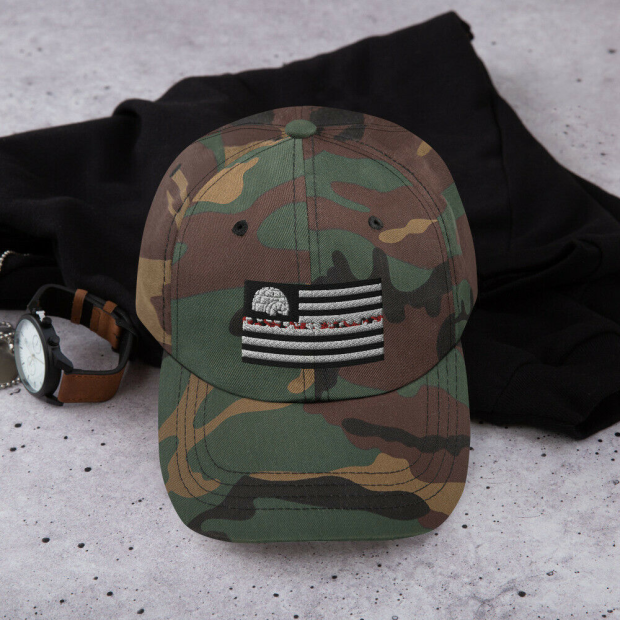
A number of businesses offering boogaloo-related items normally sell firearms, firearms accessories, ammo, or “tactical” gear. Fenix Ammunition, a Michigan-based company, has enthusiastically promoted boogaloo ideas and memes since 2019 and has sold boogaloo stickers and jerseys. “The boogaloo has already mutated, metastasized, and spread far beyond the understanding of the mainstream media,” the company posted on its Facebook page in February 2020. “We’d like to think our efforts have contributed in some small way.” That same month, declaring that Virginia legislators supporting gun control legislation seemed “determined to kick off the Boogaloo,” Fenix offered free shipping to all Virginia residents. In July, however, Facebook took down Fenix’s page on the site, as well as its Instagram account, apparently because of its boogaloo-related content.

Other businesses have also sold boogaloo items or used boogaloo ideas to attract customers. Norton Concealment, for example, a Georgia-based company that primarily sells gun holsters, has frequently used boogaloo-related hashtags such as #boogtime, #boogaloo, and #boog to help advertise its wares on Facebook. Ark Tactical, a gun store in Lakewood, Colorado, has shared numerous boogaloo memes and hashtags on its Facebook page, the latter including #bigigloo, #largeluau, #largeiceshelterbuildersunion, and more. Ark Tactical also frequently uses the slogan “We Luau on Thursdays.”
A Tennessee-based company, Shall Not Comply, which primarily sells gun-themed and right-wing-themed apparel, began offering “Hawaiian Luau” patterned accessories for hearing protectors (used by shooters), as well as its own “Boogaloo Bound” shirts. HolsterCo LLC, a Michigan business that sells holsters and firearms has sold its own boogaloo-related shirts and decals since September 2019. Patch Ops, an Ohio-based company that sells clothing patches, has offered a variety of boogaloo-related patches for sale featuring slogans such as “Boogaloo 2020,” “Boogaloonia,” and “The Boog to Resist Tyranny.” The Kentucky-based Bad Moon Armory, which makes custom parts for AR-15 assault-style weapons, debuted photos on Facebook in August of a boogaloo-themed Cerakoted AR-15 lower receiver featuring a tropical shirt design. “Everybody wants to be a #BoogBoi,” the business posted, “until it’s time to get lei’d.”
Companies’ attempts to link themselves to the boogaloo-- either to increase sales or because of ideological affinity (or both)–has helped spread the boogaloo concept, just as a decade ago, many businesses helped spread the Three Percenter concept in exactly the same ways.
VIII. Notable Boogaloo Arrests and Incidents
Though just a year old, the boogaloo movement has already established a disturbing record of criminality that includes murder and terrorist plots. The heavily weapons-oriented subculture of the movement, combined with the extreme anti-government and anti-police nature of its ideology and its fixation on a future boogaloo is a mix that lends itself to adherents embracing unlawful tactics.
Boogaloo-related criminal incidents in 2019-2020 include the following:
- St. Cloud, Minnesota, April 2021: The FBI arrested Michael Paul Dahlager, a self-proclaimed boogaloo boi, and charged him with illegal possession of a machine gun. The FBI first learned of Dahlager in November 2020 when a source informed them that Dahlager possessed a homemade firearm suppressor and a 3-D printed “drop in auto sear,” a part that is designed to convert a semi-automatic weapon into a machine gun. In February 2021, Dahlager gave the FBI source two auto sears and the FBI recovered six more and a silencer when they arrested him. Dahlager ultimately pleaded guilty to possessing two drop-in auto sears and was sentenced in January 2022 to 24 months in prison followed by three years of supervised release.
- California, April 2021: Four members of the “Grizzly Scouts”, a boogaloo-oriented group that included Steven Carrillo, were indicted by a grand jury in connection with their efforts to obstruct justice and destroy records relating to the Carrillo shootings. The four men were identified as Jessie Alexander Rush, Robert Jesus Blancas, Simon Sage Ybarra, and Kenny Matthew Miksch. According to the indictment, Carrillo messaged the other Grizzly Scouts to tell them that he killed a federal officer and warned them that he was about to confront Santa Cruz sheriff’s deputies in an engagement that resulted in the death of another officer. The Grizzly Scouts then immediately began to cover up their association with Carrillo. By September, all four members had pleaded guilty to conspiring to obstruct justice.
- Raven, Virginia, March 2021: Jaap Willem Lijbers, an undocumented Dutch citizen living in Virginia, was arrested on weapons and immigrations charges, when federal agents raided his home and recovered a Radical Firearms RF-15 military-style rifle and five magazines, including one that was loaded. According to the criminal complaint, Lijbers was a boogaloo boi who was a member of the private Facebook group that included Steven Carrillo and was in contact with both Benjamin Ryan Teeter and Ivan Harrison Hunter. During his communications with other boogalooers, Lijbers reportedly encouraged others to commit acts of violence at political rallies and encouraged violence against law enforcement officers in a “pig roast.” Lijbers was charged with illegal possession of a firearm while being unlawfully in the United States and he pleaded guilty to the charge in April. He was sentenced shortly thereafter to time served.
- Louisville, Kentucky, February 2021: Addam Turner was arrested and charged with menacing and resisting arrest for a December 2020 incident during which he confronted St. Matthews Police officers who had pulled over the protest caravan he was participating in while “openly carrying an AR-pistol and an additional handgun.” Turner also threatened police officers on Twitter and Facebook. Turner was part of the “United Pharaoh’s Guard,” which identifies as a boogaloo group. He was sentenced in July 2021 to six months in prison.
- Louisville, Kentucky, February 2021: John Subleski was arrested after he shared multiple posts on social media that advocated for rioting and violence and then later fired his weapon at a motorist during a January 6, 2021, riot in Louisville. According to the indictment, Subleski was a leader of the United Pharaoh Guard, a boogaloo group based in Louisville. He was sentenced in July 2021 to time served (five months) and a three-year term of supervised release.
- Louisville, Kentucky, February 2021: Jacoby Glenn was arrested for allegedly damaging a vehicle and threatening its occupants at gunpoint while participating in a caravan of vehicles blocking traffic in Louisville in December 2020. Glenn chased down a car that tried to bypass the blockade and then pointing a handgun at passengers. Glen is a member of the United Pharoah’s Guard, a Louisville boogaloo group. He was charged with two counts of first-degree wanton endangerment, first-degree rioting, and first-degree criminal mischief and obstructing a highway in connection to incident.
- San Antonio, Texas, December 2020: Bexar County Sheriff’s deputies arrested Tyler Joseph Light while executing a search and arrest warrant on him for an alleged violation of a protection order and terroristic threats. Deputies seized a handgun from Light’s waistband, an AK-47 assault style rifle and ammunition, all of which was illegal for the subject of a qualifying protection order to possess. Light, a self-proclaimed boogaloo supporter – had been placed under a permanent restraining order in November 2020 for committing family violence and he also allegedly made threatening statements to murder law enforcement officers. He pleaded guilty in June 2021 to a federal firearm charge and was sentenced in August to two years in prison.
- San Antonio, Texas, October 2020: The FBI arrested Cameron Emerson Casy Rankin for unlawful possession of a weapon after they found a semi-automatic rifle in his apartment while executing a search warrant. Despite having been judicially committed to a mental institution when he was younger – and therefore not allowed to own a weapon – Rankin repeatedly photographed himself with firearms and made threats against various government agencies. In a Facebook post shared in May 2020, Rankin wrote, “I’m BOOGALOO we hate police.” In April 2021, Rankin pleaded guilty to one count of possession of a firearm by one who has been judicially committed to a mental institution and in December he was sentenced to 24 months in prison.
- San Antonio, Texas, October 2020: Ivan Harrison Hunter was arrested and charged with one count of participating in a riot following an investigation into his activity during the May protests that occurred in Minneapolis following the death of George Floyd. According to court documents, Hunter was captured on video on May 28 while firing 13 rounds from an AK-47 style rifle into the Minneapolis Police Department’s Third Precinct while people were still inside. Hunter is a self-described member of the boogaloo movement and he was allegedly in communication with Steven Carrillo, Michael Solomon, and Benjamin Teeter, all of whom have been arrested for criminal activity associated with the movement. Hunter pleaded guilty to a single count of rioting in September 2021.
- Dundalk, Maryland, October 2020: The FBI arrested 39-year-old Frank William Robertson Perry after agents raided his home and discovered a rifle, ammunition, and a tactical vest. Perry is prohibited from owning firearms due to a past second-degree burglary conviction. The FBI’s Joint Terrorism Task Force identified Perry as a boogalooer, and Perry allegedly shared boogaloo-related content on his Facebook page. Perry pleaded guilty in March 2021 to illegally possessing a firearm and was sentenced to six months of home confinement in July.
- Michigan, October 2020: Federal and Michigan state law enforcement agencies arrested 13 people who were allegedly plotting to kidnap Michigan Governor Gretchen Whitmer. In addition, the plotters, who were part of a group called “The Wolverine Watchmen”, allegedly discussed targeting police officers, using violence to spark a civil war, and storming the Michigan capitol. According to court documents, the men said that they were training for the boogaloo, and their leader went by the moniker “Boogaloo Bunyan” online. Other members wore Hawaiian shirts and openly talked about the boogaloo.
- Madison Heights, Wisconsin, October 2020: 43-year-old Eric Allport was shot and killed by FBI agents after he opened fire on agents who were trying to execute an arrest warrant for a federal weapons offense. Allport has since been claimed by several boogalooers as a member of the movement, though his involvement has not been verified by the ADL.
- Ranson, West Virginia, September 2020: Timothy John Watson was arrested for allegedly selling devices that could turn semi-automatic AR-15 rifles into fully automatic machine guns to others, including several boogalooers. Watson’s website contained references to the boogaloo and prosecutors alleged that among Watson’s customers were Steven Carrillo, Benjamin Ryan Teeter, and Michael Solomon. Watson pleaded guilty in March 2021 to possession of an unregistered firearm silencer and was sentenced to a five-year prison sentence in October.
- Minneapolis, Minnesota, September 2020: Michael Solomon and Benjamin Ryan Teeter, both self-proclaimed boogalooers, were charged with conspiring to provide material support to Hamas. The two men also discussed destroying a courthouse, sparking a riot by attacking police and white supremacists at protests, and killing politicians to further their efforts to overthrow the U.S. government. The pair expressed to an FBI informant posing as a member of Hamas their desire to serve as “mercenaries” for Hamas to make money for their movement. In July, Solomon and Teeter provided the informant with five silencers and showed an interest in manufacturing more silencers as well as fully automatic weapons, reportedly believing they would be used by Hamas to attack Israeli and American soldiers. Teeter pleaded guilty in December 2020 to conspiracy to provide material support to Hamas and Solomon pleaded guilty in May 2021 to the same charge.
- Gilroy, California, August 2020: Alan Viarengo was charged with felony counts of stalking and harassing a public official after allegedly sending at least 24 anonymous letters to the Santa Clara County Health Inspector that harassed and threatened her for implementing measures limiting the spread of the coronavirus. Viarengo allegedly repeatedly used the term “boogaloo” and associated imagery in his letters. Following his arrest, police seized more than 100 firearms, as well as explosives and ammunition from Viarengo’s home.
- Lancaster, Texas, June 2020: A 29-year-old bodybuilder, Philip Russell Archibald, was charged with conspiracy to distribute controlled substances, namely steroids. According to prosecutors, Archibald was “publicly tied” to the boogaloo movement: he followed multiple Instagram accounts dedicated to the concept and allegedly discussed using “guerrilla warfare” against National Guardsmen patrolling Black Lives Matter protests.
- Bartonville, Texas, June 2020: Former Marine Daniel Austin Dunn was indicted for making threats against police officers on Facebook and Twitter. Dunn, who possessed several firearms, allegedly referenced the boogaloo in his posts and in one instance he shared an image of a boogaloo flag.
- Santa Cruz, California, June 2020: Air Force sergeant Steven Carrillo was arrested after opening fire on police officers in an ambush that killed one of them. Police were seeking Carrillo because he had allegedly been linked to a May 29 shooting in Oakland that killed a Federal Protective Service security guard. According to the FBI, Carrillo was associated with the boogaloo movement and investigators found a ballistic vest with a boogaloo patch in his vehicle. Prior to his arrest, Carrillo allegedly wrote the word “boog” in blood on the hood of a vehicle he had hijacked. Carrillo has been charged with 19 felonies, including murder and attempted murder. An accomplice, 30-year-old Robert Justus, who allegedly drove the vehicle during the May 29 attack, is facing charges of aiding and abetting murder, as well as attempted murder.
- Columbia, South Carolina, June 2020: Kevin Ackley was arrested for inciting a riot and aggravated breach of peace after he allegedly threw a water bottle at law enforcement officers during a protest. According to the Richland County Sheriff’s Department, Ackley wore boogaloo clothing, including a hat that read “Boojahideens for Liberty,” and was in possession of a boogaloo flag. A day earlier, Joshua Barnard, a self-proclaimed boogalooer, was arrested during a May 30 protest. Barnard was charged with breaking into a motor vehicle, instigating a riot and a number of other charges for actions that allegedly included stealing a police jacket from a Columbia Police Department vehicle. He also faces related to marijuana distribution and was rearrested on June 12 on charges related to the alleged sexual exploitation of a minor.
- Chattanooga, Tennessee, June 2020: Trevan Young, a Black man, was arrested at a George Floyd protest after police allegedly discovered a disassembled AR-15 in his backpack as well as multiple AR-15 magazines, two of which were loaded and easily accessible. Young was also carrying a sign referencing Duncan Lemp and Breonna Taylor. He was charged with possession of a firearm with intent to use it for harm, disorderly conduct, and resisting arrest. Young had reportedly liked and shared boogaloo content on Facebook.
- Las Vegas, Nevada, May 2020: Three boogalooers– Andrew Lynam, William Loomis and Stephen Parshall--were charged with conspiracy to cause destruction and possession of an unregistered destructive device (Molotov cocktails) at a Black Lives Matter protest. The three men, who were part of the same Nevada-based boogaloo Facebook group, allegedly hoped to use violence to incite BLM protesters against the police, and had plans to blow up a nearby energy substation as well as a building associated with a local recreational area. In July 2020, one of the men, Stephen Parshall, was also charged at both the federal and state level with sexually abusing his teenage stepdaughter.
- West Odessa, Texas, May 2020: Ector County sheriff’s deputies arrested Wyatt Winn as part of a group of eight people who allegedly engaged in an armed standoff with local law enforcement over lockdown measures. According to the sheriff, six of the protesters were carrying “AR-15 type weapons” and were charged with possessing firearms on a licensed property, while a seventh was charged with interfering with a peace officer’s duties. According to his social media, Winn followed about two dozen boogaloo-related pages on Facebook, shared photos of himself posing with a group of armed men wearing Hawaiian shirts, and shared memes referencing Duncan Lemp.
- Loveland, Colorado, May 2020: Federal agents arrested Bradley Bunn, charging him with possessing destructive devices after allegedly finding four pipe bombs during a search at his residence. Following his arrest, Bunn told investigators that he was, “willing to take out a few law enforcement officers in order to wake people up to what’s going on.” Though it is not confirmed that Bunn was involved in the boogaloo phenomenon, several Colorado boogalooers made online comments after his arrest, suggesting they knew him and were all part of the same circle. In March 2021, Bunn pleaded guilty to five felony counts related to the possession of pipe bombs and was sentenced in October to time served and three years of supervised release.
- Texarkana, Texas, April 2020: Aaron Swenson, a 36-year-old Arkansas resident, was arrested in Texas after posting a livestreamed video to his Facebook account while he drove around looking for a police officer to ambush and execute. According to authorities, Swenson wrote on Facebook, “I feel like hunting the hunters.” When arrested, Swenson was wearing an armored vest; police found several loaded firearms in his vehicle. Swenson has been charged with attempted capital murder of a police officer, attempted murder, and making a terroristic threat against a police officer. A review of Swenson’s Facebook account reveals that he had liked more than a dozen boogaloo-related groups and had shared several boogaloo images on his own page. In an homage to Duncan Lemp, Swenson had also updated his profile picture to a photo of himself wearing a Hawaiian shirt and an armored vest, tagging the photo with the hashtag #HisNameWasDuncan. In September 2021, Swenson was sentenced to 50 years in prison.
- Belton, Missouri, March 2020: White supremacist Timothy Wilson of Raymore, Missouri, died during a shootout with FBI agents conducting a sting operation on him. Wilson showed up for a meeting with the FBI agents to pick up an inert explosive device he had sought to obtain from the undercover officers, which he allegedly intended to use to target a local hospital. Wilson, who was associated with two Neo-Nazi groups and was the subject of a long-running federal investigation, reportedly referred to his plot as “Operation Boogaloo.” It is not clear if Wilson was simply using the term “boogaloo” or if he had actively been involved in the boogaloo movement itself.